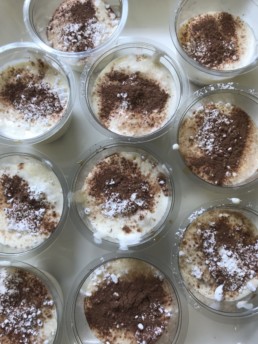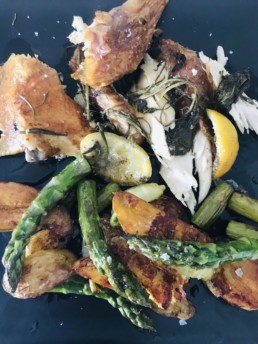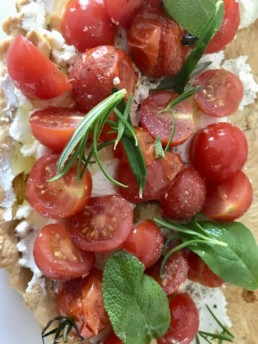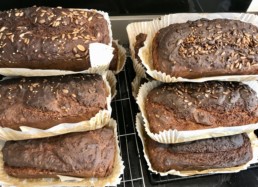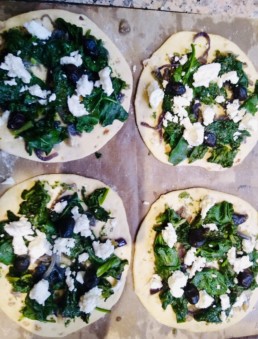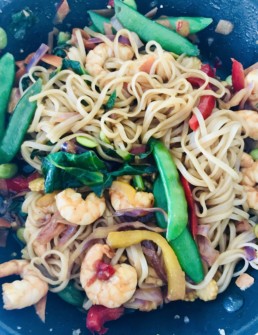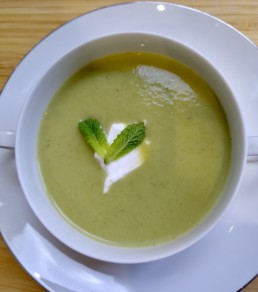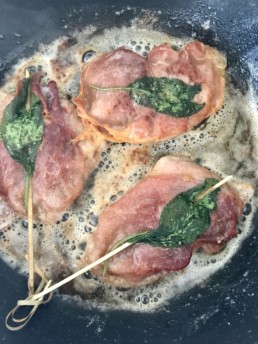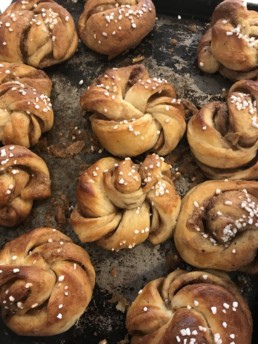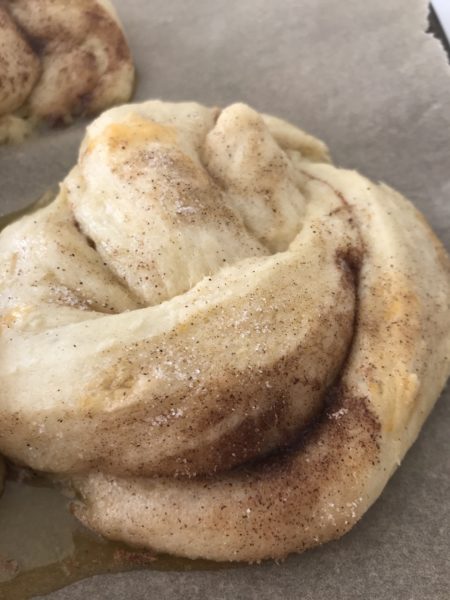What's for Supper - pretty little Tiramisu
Tiramisu is so quintessentially Italian it has become a cliché. That's a shame, as this fairly simple dessert can be blissfully delicious if made properly. The name means "cheer me up" or "pick me up" in Italian. Made without too much fat, and in small portions, that is exactly what a good Tiramisu offers - not least on account of its content of strong coffee.
Some recipes include double cream, which is not authentic and makes for a cloying result. I use Savoyard biscuits, cold coffee, Kahlua liqueur, egg, sugar and Mascarpone. Plus a little grated chocolate, or cocoa powder, to dust on top. I quite like to top with a very inauthentic juicy raspberry, to add a bit of acidity to an otherwise sweet dessert. I have been known to add a few raspberries between the biscuit and cream layer too, but I am aware that this is totally off piste.
First, make a really strong, espresso type coffee and pour it into a shallow bowl or into a small shallow tin to cool down. If you are using proper small espresso shots, use two for this quantity. And the same volume in booze, I reckon.
I tend to start with how many eggs I want to use. For this recipe, which made 10 small desserts, I used 3 eggs which I started by separating. I added 3 tablespoons of caster sugar to the egg whites and used my hand held electric beaters until the whites were firm enough to be turned upside down without leaving the bowl. Next, I used the same whisk attachments to beat the egg yolks with 125g caster sugar until thick and pale. So that's about 3 minutes and only one pair of whisk attachments to wash up! I then add about 180g Mascarpone as lightly as I can, to the yolks, before carefully folding the egg whites into the creamy yolks, taking care not to over work it. The texture is essential - it should be ultra light. If you stir rather than fold the two egg mixtures together you get a heavy dessert.
Next, I add coffee liqueur to the cold coffee.
I can be a little OCD in the kitchen and I love lining things up. When I eat shell-on prawns, which I love if the prawns are proper cold water, Arctic beasties with a good elastic texture and a proper salty flavour (few things are worse than "pappy" freeze-dried prawns - they should not be eaten), I peel the juicy prawns one or two at a time and greedily dip them in mayo, and then I start to line up the heads around the rim of my plate. It's part of the pleasure for me. Looking at the rows of little black prawn eyes and heads - and shells - afterwards gives me as much pleasure as eating them. I know, I should get out more.

Anyway, lining up my pots or little glasses before filling gives me the same kind of pleasure, as does the repetitive conveyor belt like work which ensues.
Dip a couple of biscuits rather hastily in the liqueur coffee. Break as needed to arrange in the base of your chosen vessels. Scoop in some of the eggy cream. If you choose to make one large dessert then you crate several layers, ideally in a glass bowl and in such a way that the layers show very neatly. When making mini versions, there is only room for a base layer of biscuit and a top layer of cream.
Dust on some cocoa powder, or sprinkle on some grated dark chocolate. Or place a raspberry on top.
Chill before eating.
What's for Supper - it's time for another roast chicken...
A chicken a day probably doesn't keep boredom away but a chicken a week is most defiantly part of my cooking routine. I simply never tire of a really good quality chicken, roasted simply with a lemon and some herbs, plenty of salt, pepper and olive oil, and with whatever accompaniments the season offers.
We are in the middle of the wonderful local asparagus season, which normally brings with it asparagus festivals, picking and special menus. It feels very sad not to have this outstanding vegetable celebrated with the pomp it deserves.
This, to me, remains one of the the most delicious meals I can think of. I just never tire of it and I enjoy it as much when I first cook it, and the chicken meat is juicy and tender, and the skin hot and crisp, as I do the following day when it is cold. That's when I enjoy it with mayo, pickled cucumber and a slice or dark rye bread.
My household is small so I like cooking smaller chicken of just above a kg in weight. I actually prefer smaller chickens to larger ones even when I cook for many. They are more aesthetically appealing to me, and I prefer to roast two small chickens instead of one large one. And they cook quicker, obviously.
I always seek out free range chicken, from smaller producers. The better life the chicken's has had, the better it tastes on the plate.
Chicken is often over cooked, which makes it dry and wolly. For a small chicken, just over an hour at 190C is enough. For a very large bird I would assume 1h 45 minutes and for a regular medium sized bird 90 minutes. Stick the tip of a knife in the thickest part of one of the things to check doneness. If the juices are pink, or red, there are still uncooked parts so stick it back in the oven for another 10-12 minutes. If the juices run clear, the chicken is cooked.
To cook, push into the cavity one whole lemon, washed and pierced with a knife to encourage the juices to escape, and some hole hard herbs such as sage and rosemary, and plenty of sea salt and pepper. I drizzle olive oil over the skin and season again before putting it in an oiled roasting tin.
When 30-35 minutes of the roasting time remains, I add some firm potatoes, halved lengthways, washed, skin on, and turn them in the oil. When adding asparagus, I cut off the tip, and then cut the stalk into one or two smaller pieces. I add those to the pan when 4-5 minutes remain and finally, a couple of minutes before I am going to take out the chicken I throw in the asparagus tips. Make sure they are turned in the salty hot cooking fats and that they don't cook for more than a minute or two.
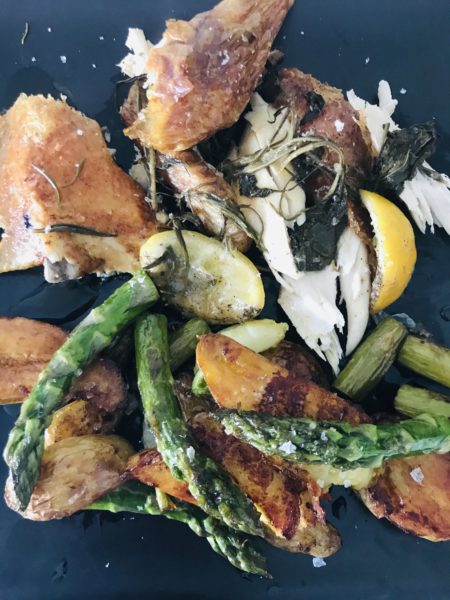
Remove the tray from the oven. Leave the chicken to rest for 5-10 minutes. You can keep the tray of potatoes in the oven once you switch it off, if you prefer them to stay very warm.
Carve the chicken and serve with the juices from the soft cooked lemon, the crispy potatoes and the tender asparagus. It is difficult to describe just how delicious a good chicken roasted like this is.
I sometimes indulge in a dollop of mayonnaise on the side, but not always when the chicken is newly roasted. The next day however, when I enjoy it cold, mayo is a must.
What's for Supper - Tomato and goat's cheese tart
I am going to give you my super simple recipe for Tomato tart based on shop bought short crust pastry. I am a sucker for anything shortcrust, not least very buttery shortbreads with an afternoon cup of Earl Grey or Lapsang Suchong. But if you prefer puff pastry, then go for that, it works just as well and it doesn't require blind baking, as described below.
As you will have discovered, one of my constant kitchen staples are cherry tomatoes. I love them. They are so versatile both in their uncooked form and when roasted, used in sauces or marinated.
Tomatoes are underpinned by acidity, no matter how ripe and sundrenched - and god knows that is not usually how they come from the supermarkets. Combining them with a creamy, lemony goat's cheese works wonderfully well. Both those ingredients take well to being drizzled with Balsamic vinegar or Pomegranate molasses. The latter elevates tomatoes to unexpected heights.
I had a lock down crisis earlier when I realised that all my rolling pins had ended up at work.
So, needs must, and as I scanned my shelves for good substitutes my eye fell on my favourite fizz from the wonderfully talented Mr and Mrs Fox based in East Sussex. Their blender extraordinaire, Mrs Fox, describes their Mosaic fizz as their most versatile wine. And I can only agree. As it turns out, this exquisite fizz also lends itself very well to being used as a rolling pin, and a chilled one at that. What better tool to use for rolling pastry? Placing it back in the fridge after use, I now have both a simple but utterly delicious supper to look forward to and an glass of sublime fizz eminently capable of making the most of the lemony creamy cheese and the acidity of the tomatoes. Necessity is the mother of invention, as they say.
So, roll out your pastry, short or flaky, to a around slightly larger than the circumference of your tart case. Carefully lift it into the case, lowering it slowly and easing it from the centre and out, making sure not to stretch it nor to create air bubbles.
Line it with a round of baking parchment and weigh it down with ceramic baking beans, or some rice.
The reason is to keep the shape of it and to avoid the edges from collapsing when baking. However, the primary insurance against that is to make sure the pastry is super cold when placed in the oven. That way, the butter and flour will bind as the heat hits. When short crust pastry at room temperature is placed in a hot oven, the butter will start to melt and by the time the butter binds with the flour, the collapse is already a fact.
Place the well chilled pastry case in a hot oven - about 200C.
Bake for 12-15 minutes.
Remove from the oven. Use a metal spoon to scoop out the hot ceramic beans or rice and place in a steel or glass receptacle. Not plastic, as it will melt. Place the bare short crust back in the oven for another 5-7 minutes to bake through.
When cooled, spread a thick layer of mild goat's cheese over it, and top with a mix of roasted and uncooked cherry tomatoes, some salt and pepper, olive oil and some fresh herbs. Basil would be an obvious choice, but new season rosemary and tender sage work well too.


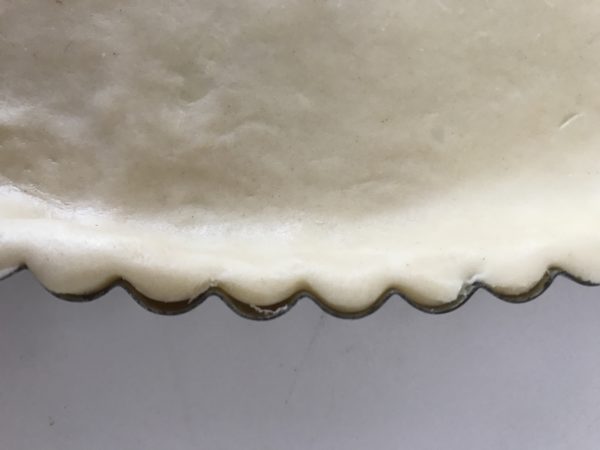

What's for Supper - Danish Fennel & caraway Rye bread
It has been an emotional weekend. I reopened the café on a take-out basis, and was reunited with all our regular customers albeit at a distance, and from behind my face mask. Teresa and I were overwhelmed by the positive response and by those who said we had lifted their spirits beyond anything by offering what felt like a small return to normality. Not that this is anything like normality, needless to say.
Two things were clearly more missed than anything else, and they were our cinnamon buns and our Rye bread. I had so many lovely conversations about bread, and I thought I would share the super easy recipe for one of my longest standing recipes both in my bread making classes and in my café.
The baking soda based rye bread is the very first bread we teach on the Beginners Bread class, which was the first class I designed back in 2008, when I first started the school. I like to kick start what is a wonderfully relaxed Sunday morning class of mixing, kneading, shaping and baking with just a little bit of tongue in cheek competitiveness, by stating that this bread should take no more than 6-7 minutes to weigh out, mix and pour into a paper lined loaf tin, before it bakes for almost an hour and a half. Soda bread is mixed like a cake batter so its a brilliant confidence builder for complete novices, and a good way to get going before tackling yeast risen doughs and the need to knead, rise, shape and prove.
Fennel and Caraway Seed Soda Bread
Split the making between dry and wet ingredients. I am always looking for ways to minimise washing up when I cook at home. For this bread, I am therefore prone to opening my 500g pot of yoghurt and adding the two syrups straight into it. No need to create a sticky mixing bowl.
Switch the oven on to 180C as you will have mixed the bread within minutes.
WET INGREDIENTS
500ml Natural Greek style yoghurt
1 tablespoon treacle
2 tablespoons golden syrup
This bit takes 1 minute.
Now, weigh up the dry ingredients in a large mixing bowl as per below. That takes about 4 minutes.
DRY INGREDIENTS
150g strong white bread flour
90g wholemeal, barleycorn or other flavoursome organic flour
60g organic rye flour
1 teaspoon fennel seeds
1 teaspoon caraways seeds
1 teaspoon Maldon sea salt
40g larger seeds - a mix of sunflower/pumpkin seeds is good
1 large teaspoon bicarbonate of soda
Tip and scrape out all the contents of the yoghurt pot into the dry. Fold and mix but only just so wet and dry combine, no more.
As I am lazy I like using paper loaf tin cases rather than cutting my own baking parchment.
Pour into the paper lined tin and bake in the lower third of the oven. All in all, a 6-7 minutes job, max.
Bake for 90 minutes. Tip out of the tin and cool, in the paper, on a cooling rack.
The scent from this wonderfully savoury yet molasses infused bread is intoxicating - but don't be tempted to slice it too soon, as it will fall apart if sliced while still hot.
This bread is insanely good with savoury toppings such as mature hard cheese, smoked salmon & dill mousse and prawns and mayo. I make Danish open sandwiches for the café every day. They are so easy to make, lend themselves to be topped with so many different things, and look as lovely as they taste.
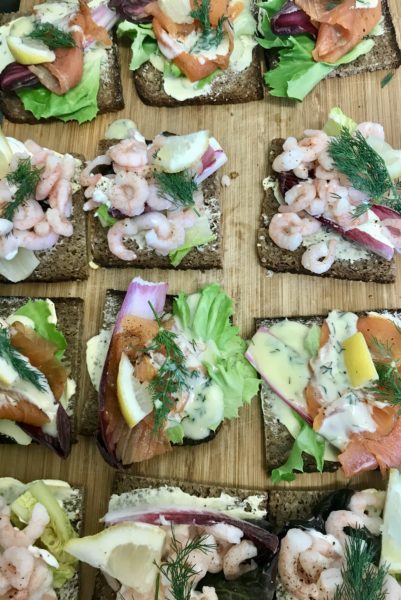
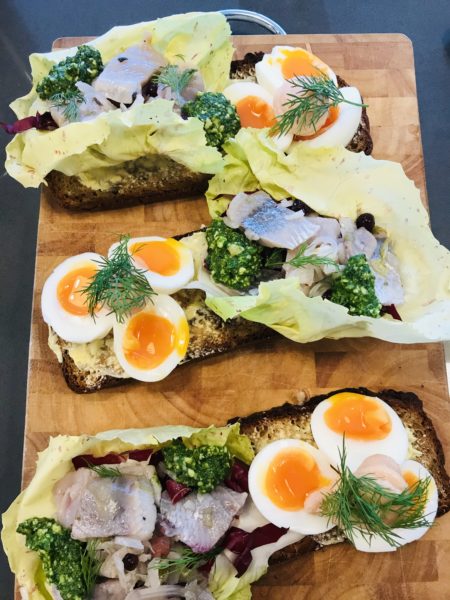
What's for Supper - home made pizza
Making pizza is one of the most enjoyable activities you can possibly share with your children and teens, or let them loose on alone.
The only addition needed for pizza to a standard 4-ingredient bread dough is olive oil.
We make a lot of bread for the café and we teach how to in our many bread making classes.
This slightly unusual pizza recipe is from our teaching chef Jackie Hobbs.
Pizzettes – dough enough for 4 x15cm pizzettes
The recipe I have given for the dough can be adapted, depending on what you have available. You can of course use 250g strong white flour and no nuts. I would normally use fresh yeast, but you are more likely to have sachets of fast action yeast in your cupboards. I made the dough in the morning and divided into portions which I then put in the fridge ready to roll out and use in the evening. Coating the dough in oil at this point gives a greater crunch to the crust.
Dough -
100g strong white bread flour
100g semolina flour
50g buckwheat flour
Handful chopped nuts
1tsp salt
1 tsp fast action yeast
130g warm water
2 tbsp oil
Weigh out the dry ingredients in a bowl and then add the wet. Mix until the whole lot comes together in a bowl. Then knead by hand for about 10 minutes or use a dough hook in a food mixer to make an elastic dough which will take about 5 minutes. It should be smooth and springy. Shape into a ball and then put the dough into a clean bowl, cover with clingfilm and leave to prove for about an hour till double in size approximately. Once it has risen, divide the dough into 4 pieces on a floured work surface, shape each into a ball, coat each with a little oil and leave to rise for about 30 minutes if at room temperature. Use a rolling pin to roll out each ball of the dough into a 15cm rounds and place onto a baking tray. Then add your toppings of choice and bake for about 10 minutes at a temperature of 250 degrees centigrade.
Topping Options
You could stick with a traditional topping and spread each dough base with a tomato sauce, followed by mozzarella or spread on a pesto or a simpler herb oil which makes a “lighter” topping. I used a herb oil made from oregano, a little garlic and some sunflower oil. Then topped with caramelised onions, wilted spinach, goat’s cheese and black olives.
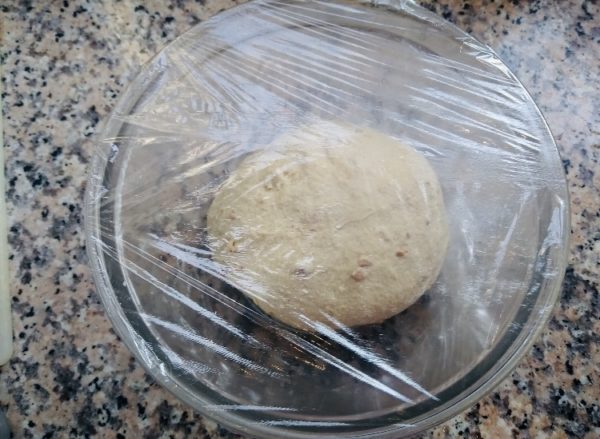
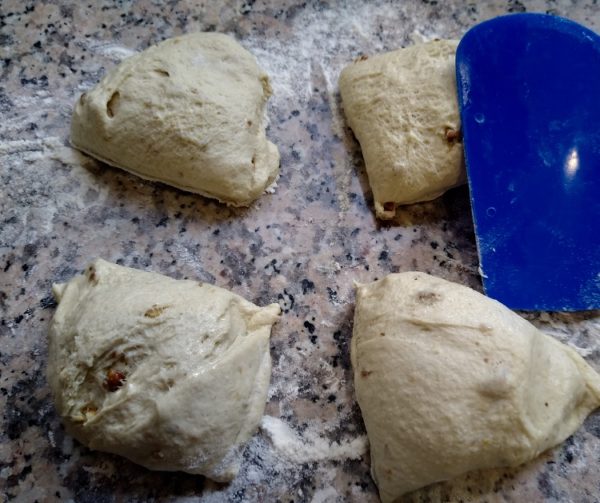
Buon appetito!
What's for supper next:
The big news is that we are re-opening for take-outs this Saturday, the 25th April.
We will offer fresh bread, pastries, filled breakfast rolls, open rye sandwiches, filled Focaccia, salads and our much loved coffee. We will be open 9am-1pm Wednesday through to Sunday with all food presented in take-away boxes and cups. Safe queuing on our large terrace and lawn. Safe distance card payments and plenty of anti septic sprays. We will wear face masks and gloves.
As this means that I will be spending a lot more time preparing food for take away, the recipes will appear a little more sporadically. I will aim for 2-3 per week.
What's for Supper - Thai prawn noodles
Today's supper is a simple Thai style noodle dish, with our without prawns/chicken/pork/beef.
You will need glass noodles, a mix of crunchy vegetables cut into strips such as carrot, spring onions, red onion, any colour peppers, mange touts, baby corn, green beans, red or green cabbage, Bok Choi red or green chilli, garlic and your chosen animal protein, if using. I used half a bag of frozen, raw large prawns. For seasoning you need (some or all) lime juice, fish sauce, soy sauce, Ketjap Manis, sesame oil. If you don't have any of the salty/umami ingredients ie soy and fish sauce, use normal salt and a small dollop of Marmite or a splash of Worcester sauce. If you don't have the sweet Ketjap Manis, add some brown sugar. Taste your way to that intoxicating Thai mix of sweet, sour, salty, spicy and a bit of bitter.
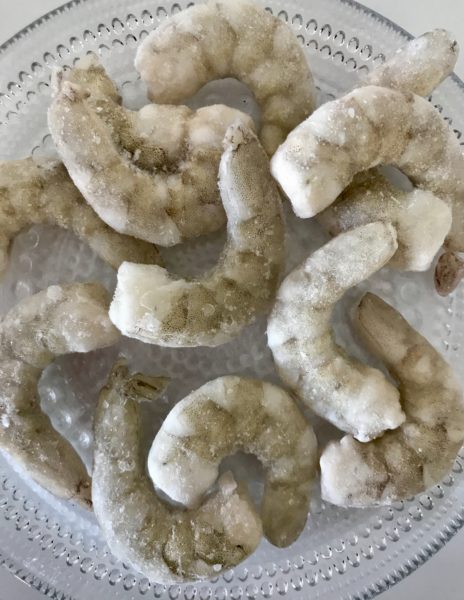
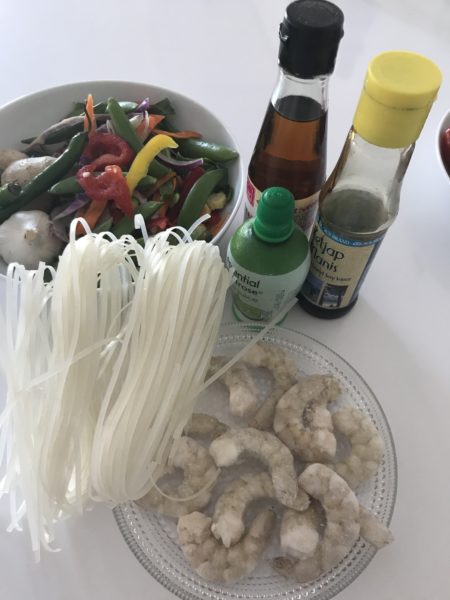

Drop the glass noodles into boiling water, leave them to simmer until soft but not sloppy.
Drain into ice cold water.
Heat sunflower oil in a large frying pan, flash fry the vegetables for 1 minute, add the prawns/thin strips of chicken/beef/pork and keep frying on high temperature for 2 more minutes. Add the wet seasoning, taste your way to perfection.
Drop in the noodles.
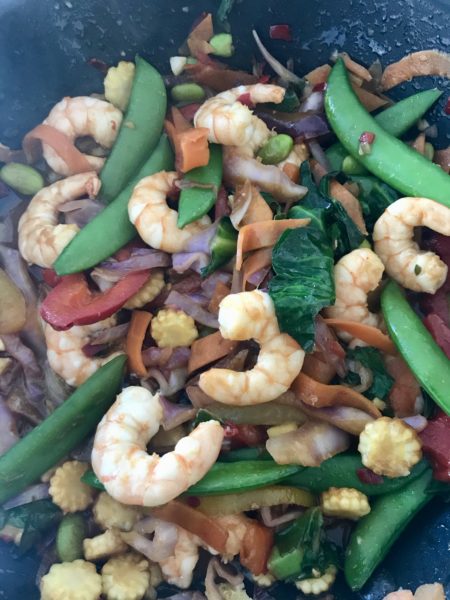
Have a cold lager with this. If you prefer a white wine go with something aromatic like a Gewürztraminer or an off dry Riesling. Definitely not anything oaked, like a Chardonnay and spicy food is not the right match for any full bodied red, even when when the dish includes steak.
What's for Supper tomorrow...
Looking at the by now depleted contents of my freezer, I am thinking individual salmon en croute..
What's for Supper - Cucumber soup
Every day I receive beautiful and inspiring photos from all the teaching chefs, who all to a woman treat their families and loved ones to amazing lock-down food, based on more or less store-cupboard ingredients.
The inspiring Jackie Hobbs made this soup while the weather was warm.
Although there is a very chilly wind in Cambridge today, the sun continues to shine from a clear blue sky which turns ones thoughts to more summery food.
This soup is made from such humble ingredients - one cucumber and one potato, plus a splash or milk and stock. It tastes lovely warm as well, if you prefer warm soup to cold. Our little milk rolls would go very well with this - click here for the recipe
Cucumber soup – serves 2
This soup can be served hot or cold. If serving cold it is probably easier to make the day before. It has a delicate flavour and it is therefore important not to overpower the cucumber flavour with too much onion or very concentrated stock. You could substitute the onion with a small amount of leek. I only used half of a little Knorr stock pot to 750ml of hot water. If you have any left over salad leaves, watercress or spinach, then these can be added near the end of cooking. Fresh herbs such as dill or mint could be added at this point too. If you want to make the soup dairy free or vegan then it is not necessary to add the milk as it tastes delicious without also.
1 medium cucumber
1/2 small onion
1 medium potato
1 tablespoons oil
750ml weak vegetable stock
Juice of half a lemon
75ml cream or milk
salt and pepper
Method
Prepare the vegetables:
Dice the onion and cucumber and peel and chop the potato.
Heat the oil in a large pan and slowly cook the onion with a little salt over a gentle heat until soft and translucent. Add the cucumber, potato and vegetable stock, bring to the boil and then turn to simmer for about 15 minutes, or until the potato is soft. At this point add any additional leaves or herbs, if using. Leave to cool and then process in a liquidiser. Add the cream or milk, if using, and juice of half a lemon. Taste and season with salt and pepper.
What's for Supper tomorrow
Now that all days tend to follow the same rhythm it hardly seems relevant to distinguish between weekday and weekend food. I made steak Béarnaise the other day, and Saltimbocca was on the menu midweek. I have a craving for the sweet, sour, hot and spicy flavours of Thailand and am planning to make Thai style glass noodles with prawns for supper.
What's for Supper - Saltimbocca, a super simple gourmet supper
Saltimbocca remains one of my all time favourites, and is a perfect example of what makes Italian food so brilliant.
Respect for local produce, an instinctive understanding of what goes together, few ingredients, simple cooking methods and utter bliss on the plate. My life long love affair with Italy started when I visited on an Inter-rail trip as an 18-year old History of Art student. It was love at first sight. How could it not be? European trains were not the clean marvels of speed that they are today. Sleeping on dirty floors and risking cystitis rather than braving revolting toilets was the norm. So much greater the contrast when one tumbled out of the stations of Florence, Pisa and Venice to city scapes of such aching beauty and food so exquisite that it made me cry!
I had such high expectations of Venice that I was prepared for it to disappoint. It didn't. We arrived very early in the morning, after another night spent on a dirty train floor, having crossed the long Ponte della Libertà connecting Venice to the mainland, and emerging, blinking through the doors of Venezia Santa Lucia railway station straight onto the Canal Grande. I still get goose bumps when I think about that moment. The sun on the water, astounding Palazzi, the sun on my face and being carried by a perky vaporetto on a street made of water; I knew that I had fallen head over heels in love and that it would last for life.
I am a big fan of the Italian Renaissance architect Palladio, whose symmetrical country villas for rich land owners scatter the landscape between Venice and Vicenza. He also designed three beautiful churches in Venice, including the church of San Giorgio Maggiore on the island of the same name located just across the lagoon from the Piazzetta San Marco. Its classical temple façade is a brilliant white; its interior is also a brilliant white, bathed in natural light. The design is what we would probably refer to as "resolved", that is to say perfect. I find it oddly relatable to modern Scandinavian design, both a thrill and a rest for the eye. The bell-tower offers unrivalled views back over Venice and ascending it would be my top tip to anyone planning a trip to Venice when the lock down is lifted!
Anyway, back to the food!
Saltimbocca alla Romana may in fact not have originated in Rome, but in the north. Be that as it may, it is a fiendisly clever dish of just 3 main components cooked in a couple of minutes and finished off with such effortless bravura as to seem almost arrogant - a splash of Marsala. Tender escalopes, earthy sage, salty Prosciutto and sweet wine. Genius. Traditionally made with veal, I don't favour cooking veal. Even if the cruel days of crating calves to stop them from moving, in order for their muscle fibre to remain pale and tender are gone, there are serious animal welfare issues with veal. Male calves born into dairy herds are either killed at birth or shipped on long journeys to veal farms on the continent where they are kept in cruel conditions.
So I tend to use organic, free range fillet of pork, ie pork loin, or chicken when I make this dish. If you use chicken, cut through a breast fillet horizontally to crate two thin fillets. It makes a chicken fillet go twice as far! I have used pork fillet here, as I had bought one and put it in my freezer just before the lock down. I have used half a 650g fillet for this meal, and I will use the other half either in a Chinese style stir fry, or simply by pan frying medallions in butter and serving with sliced onion cooked down very very slowly to an unctuous, sweet caramel brown. This I would have to plan for a cold, rainy day, as it deserves a buttery mash to partner it on the plate.
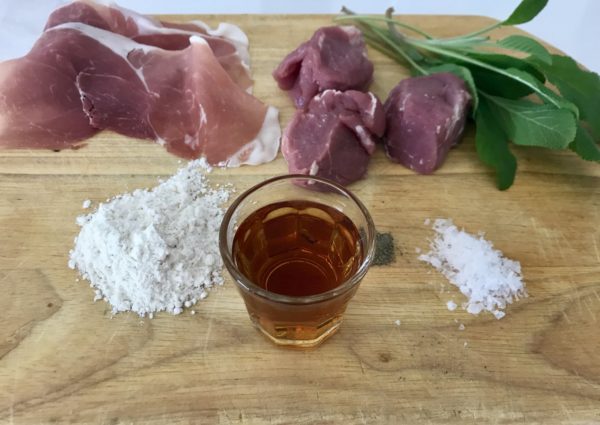
Prepare you chicken fillets or, in my case, medallions of organic pork loin.
Add a slice of Prosciutto and a large sage leaf to each escalope. Season the other side with freshly ground pepper and just a little salt - the ham is salty.

Dust with plain flour - this will make the wine, when added, go nicely syrupy.
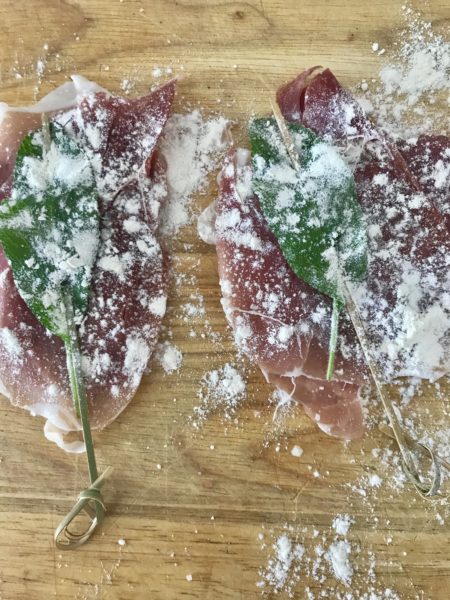
Heat a knob of butter and a lug of sunflower oil in a pan until the colour is nut brown.

Add the scaloppione, prosciutto side down. Fry over a fairly high heat for 60 seconds. Flip over.
Click to see what happens when I add the Marsala; it will spit as it goes in, then carry on letting the juices and wine reduce to a lovely syrupy consistency for about 1 minute. That's it; cooking done in 2 minutes.
I would serve this with spinach Tagliatelle cooked al dente. The dark green of the pasta looks stunning with the scarlet and green of the scaloppine, whereas white pasta doesn't. Or, serve with lemon & rosemary roasted waxy potatoes, and some wilted spinach. Delizioso!
What's for supper tomorrow
Another mouth watering yet super simple recipe from our teaching chef Jackie Hobbs, using a humble ingredient: cucumber for a chilled cucumber soup. Perfect for Friday supper, alone or as a starter, at the end of a warm day.
What's for Supper baking special - Swedish cinnamon rolls or "Kanelbullar"
I grew up in Denmark and Sweden, surrounded on the periphery by women who were all brilliant home cooks and bakers. My grandmother and all her sisters had learnt from their mum, Ida in their home in Swedish Lapland, and a couple of them had been sent to "house keeping school" and one trained as a baker and Patissière.
The Kanelbullar, literally meaning cinnamon buns, which we bake daily for the café and teach in our Bread making for Beginners class are without a doubt our signature bake. People come just for them, and often buy more to take home. The recipe is a fairly standard sweet, yeast risen dough so there is egg, butter and milk in the dough, making it soft and marshmallowy, and there is more butter and sugar as a filling, as well as cinnamon and cardamom.
We always use fresh yeast in the school and café but dried works well too.
I recommend Quick action yeast over the granules which need sponging.
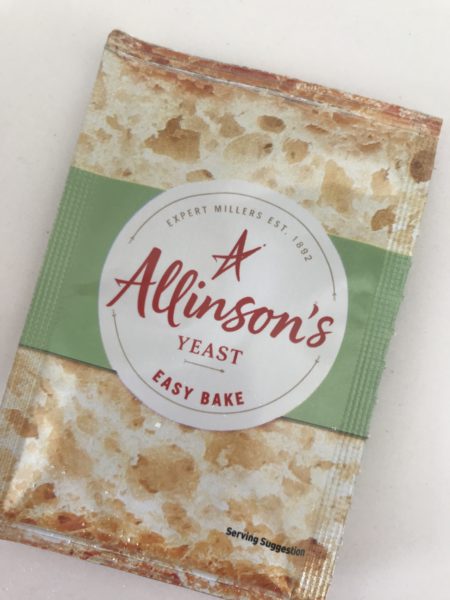
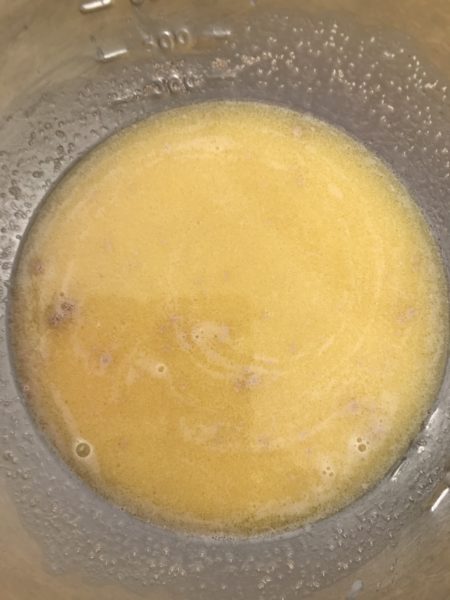
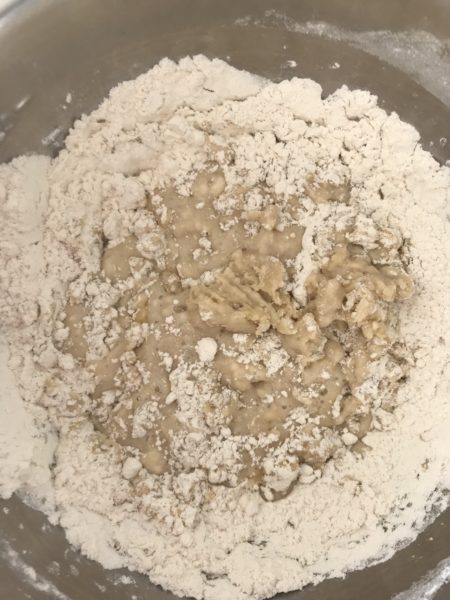
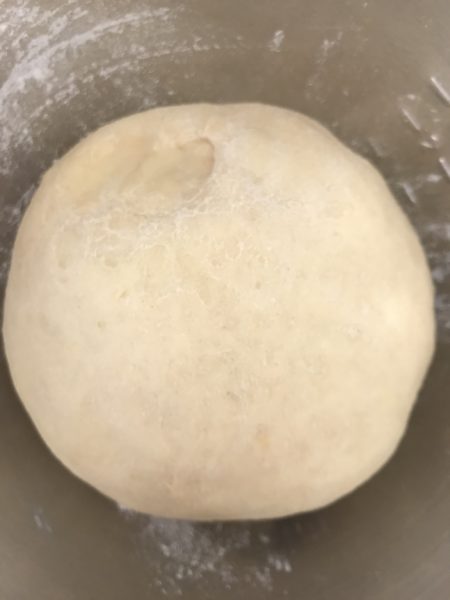
Yeast Melted butter+milk Flour+salt+sugar Risen dough
Cinnamon buns - small batch making 6 large cinnamon buns
12g fresh/3.5g quick action yeast (half a sachet)
50g butter
125ml milk
1/2 egg - mainly yolk if you can manage to control it
40g caster sugar
A large pinch of salt
1 teaspoon ground cardamom
250g plain flour
Filling:
40g soft, unsalted butter
25g caster sugar
1 tablespoons ground cinnamon
To top before baking:
1/2 egg, lightly beaten with a fork
Confectioner's sugar or normal sugar mixed with a little ground cardamom
- Melt the butter, add the milk and bring to luke-warm temperature.
- Pour it into the dry ingredients, add half or your half egg!
- Stir using a wooden spoon or dough paddle. Work it as best you can but it will be a very wet dough. Cover and leave to rise for 30 minutes.
- Mix the ingredients for the filling.
- Tip the dough out on a lightly floured work surface. Dust lightly with flour. Roll out to a strip of 8 x 15cm or so.
- Spread the filling over the dough. Fold over lengthways to a narrow long strip
- Cut into 2 cm wide strips. Twist the strips to and bring it around itself to form a lovely knot shape where you bring one end up through the open centre to secure the know., Place on baking parchment-covered baking sheets or in paper cases. Leave to prove for 45 minutes. The buns should have doubled in size and be slack and soft.

Brush with egg and sprinkle with confectioner’s sugar (or caster sugar mixed with ground cardamom). Place in the top third of a pre-heated oven and bake for 9-10 minutes or until golden
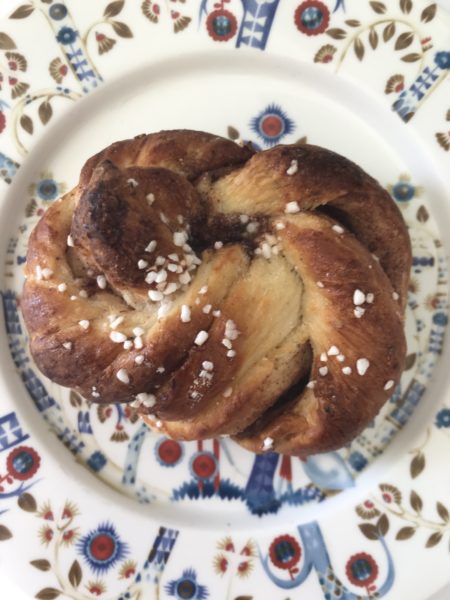
Enjoy with your cup of morning coffee...and eat them all today, or freeze. Fresh home baked bread goes stale very quickly.
What's for Supper tomorrow...
Back to Italy for one of my all-time favourite dishes; Saltimbocca alla Romana. Effortless elegance - thin escalopes of veal, chicken or fillet of pork, Prosciutto, sage and that favourite ingredient of mine: Marsala! What's not to like...
